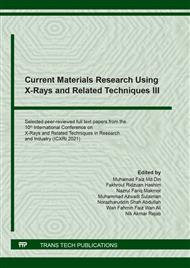[1]
K. Thanawala, N. Mutneja, A.S. Khanna, and R.K.S. Raman, Development of self-healing coatings based on linseed oil as autonomous repairing agent for corrosion resistance, Materials (Basel). 7 (2014) 7324–7338.
DOI: 10.3390/ma7117324
Google Scholar
[2]
M. Samadzadeh, S.H. Boura, M. Peikari, A. Ashrafi, and M. Kasiriha, Progress in organic coatings tung oil: An autonomous repairing agent for self-healing epoxy coatings, Prog. Org. Coatings. 70 (2011) 383–387.
DOI: 10.1016/j.porgcoat.2010.08.017
Google Scholar
[3]
H. Li, Y. Cui, Z. Li, Y. Zhu, and H. Wang, Fabrication of microcapsules containing dual-functional tung oil and properties suitable for self-healing and self-lubricating coatings, Prog. Org. Coatings. 115 (2018) 164–171.
DOI: 10.1016/j.porgcoat.2017.11.019
Google Scholar
[4]
T. Szabó, J. Telegdi, and L. Nyikos, Linseed oil filled microcapsules containing drier and corrosion inhibitor-Their effect on self-healing, Prog. Org. Coatings. 84 (2015) 136–142.
DOI: 10.1016/j.porgcoat.2015.02.020
Google Scholar
[5]
Z. Baharom, N.B. Baba, R. Ramli, M.I. Idris, and H.Z. Abdullah, Microencapsulation of natural self-healing agent as corrosion coating, AIP Conf. Proc., 2068 (2019) 1-5.
DOI: 10.1063/1.5089402
Google Scholar
[6]
S.N. Khorasani, S. Ataei, and R.E. Neisiany, Microencapsulation of a coconut oil-based alkyd resin into Poly (Melamine – Urea – Formaldehyde) as shell for self-healing purposes, Prog. Org. Coatings. 111 (2017) 99–106.
DOI: 10.1016/j.porgcoat.2017.05.014
Google Scholar
[7]
N. Shahabudin, R. Yahya, and S.N. Gan, Microcapsules filled with a palm oil-based alkyd as healing agent for epoxy matrix, Polymers (Basel). 8 (2016) 1–16.
DOI: 10.3390/polym8040125
Google Scholar
[8]
T. Yin, M.Z. Rong, M.Q. Zhang, and G.C. Yang, Self-healing epoxy composites - Preparation and effect of the healant consisting of micro-encapsulated epoxy and latent curing agent. Compos. Sci. Technol. 67 (2017) 201–212.
DOI: 10.1016/j.compscitech.2006.07.028
Google Scholar
[9]
D.H. Turkenburg, Y. Durant, and H.R. Fischer, Bio-based selfhealing coatings based on thermo-reversible Diels-Alder reaction, Prog. Org. Coatings. 111 (2017) 38–46.
DOI: 10.1016/j.porgcoat.2017.05.006
Google Scholar
[10]
Z. Cai, Z. Li, Y. Ding, J. Zheng, J. Liu, and Z. Zhou, Preparation and impact resistance performance of bionic sandwich structure inspired from beetle forewing, Compos. Part B. 161 (2019) 490–501.
DOI: 10.1016/j.compositesb.2018.12.139
Google Scholar
[11]
K. Thanawala, A.S. Khanna, and R.K.S. Raman, Development of self-healing coatings using encapsulated linseed oil and tung oil as healing agents, NACE Int. 7310 (2016) 1–9.
DOI: 10.3390/ma7117324
Google Scholar
[12]
P.R. Hondred, L. Salat, and M.R. Kessler, Tung oil‐based thermosetting polymers for self‐healing applications, J. Appl. Polym. Sci. 131 (2014) 1–15.
DOI: 10.1002/app.40406
Google Scholar
[13]
S.M. Mirabedini, I. Dutil, and R.R. Farnood, Preparation and characterization of ethyl cellulose-based core–shell microcapsules containing plant oils. Colloids Surfaces A Physicochem. Eng. Asp., 394 (2012) 74–84.
DOI: 10.1016/j.colsurfa.2011.11.028
Google Scholar
[14]
D. Abrantes, I.C. Riegel-vidotti, M. Guerreiro, S. Ferreira, C. Eliana, and B. Marino, Smart coating based on double stimuli-responsive microcapsules containing linseed oil and benzotriazole for active corrosion protection, Corros. Sci. 130 (2018) 56–63.
DOI: 10.1016/j.corsci.2017.10.009
Google Scholar
[15]
N. Shahabudin, R. Yahya, and S.N. Gan, Microencapsulation of a palm oil-based alkyd by amino resins, Macromol. Symp. 354 (2015) 305–313.
DOI: 10.1002/masy.201400085
Google Scholar
[16]
S. Ataei, S. Nouri, R. Torkaman, and R. Esmaeely, Self-healing performance of an epoxy coating containing microencapsulated alkyd resin based on coconut oil, Prog. Org. Coatings. 120 (2018) 160–166.
DOI: 10.1016/j.porgcoat.2018.03.024
Google Scholar
[17]
Z. Baharom, M.I. Idris, T.C. Lee, S.A.S.A. Bakar, and H.Z. Abdullah, Characterizations on microencapsulated sunflower oil as self-healing agent using in situ polymerization method, Mater. Sci. Forum. 1010 (2020) 433–438.
DOI: 10.4028/www.scientific.net/msf.1010.433
Google Scholar
[18]
Z. Baharom, M.I. Idris, T.C. Lee, and H.Z. Abdullah, Effects of surfactant concentration on microencapsulated waste vegetable oil, AIP Conf. Proc. 2068 (2019) 1–5.
DOI: 10.1063/1.5089404
Google Scholar
[19]
Z. Baharom, M.I. Idris, T.C. Lee, and H Z. Abdullah, Comparative study on microencapsulated of natural and waste sunflower oil as self-healing agent, Mater. Sci. Forum. 1010 (2020) 439–444.
DOI: 10.4028/www.scientific.net/msf.1010.439
Google Scholar
[20]
F. Safaei, S.N. Khorasani, H. Rahnama, and R.E. Neisiany, Single microcapsules containing epoxy healing agent used for development in the fabrication of cost efficient self-healing epoxy coating, Prog. Org. Coatings. 114 (2018) 40–46.
DOI: 10.1016/j.porgcoat.2017.09.019
Google Scholar
[21]
M. Behzadnasab, S.M. Mirabedini, M. Esfandeh, and R.R. Farnood, Evaluation of corrosion performance of a self-healing epoxy-based coating containing linseed oil-filled microcapsules via electrochemical impedance spectroscopy, Prog. Org. Coatings. 105 (2017) 212–224.
DOI: 10.1016/j.porgcoat.2017.01.006
Google Scholar
[22]
J. Lee, M. Zhang, D. Bhattacharyya, and Y. Chao, Micromechanical behavior of self-healing epoxy and hardener-loaded microcapsules by nanoindentation, Mater. Lett. 76 (2012) 62–65.
DOI: 10.1016/j.matlet.2012.02.052
Google Scholar


